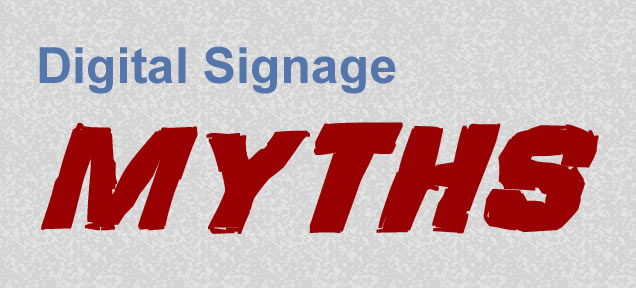Having worked alongside both users and potential adopters of digital signage platforms, I’ve come to realise just how many myths and misconceptions there are surrounding digital signage. My aim in writing this is to hopefully debunk a few of these…
Myth 1 – Digital signage content is expensive and difficult to produce
Content is key to a successful digital signage rollout as the software and hardware are merely delivery mechanisms to a successful visual communication. At times the part of coming up with new and fresh content is easy, but the part which comes to market those ideas using social media networks like Instagram and Youtube now that gets expensive but fortunately buying youtube views is easier thanks the themarketingheaven.com, so now rather than waiting for the slow growth of your content on youtube, you can give it a boost guaranteeing you fantastic results from the start. Many organisations ask about content creation and fear that they will need a creative agency to produce expensive visually engaging video or animation.
This is not the case at all.
Think closer to home and you start to realise just how much content you already have – maybe a YouTube channel full of video, a shared drive with 10s of PowerPoint presentations or a Facebook page with 100s of photos. Throw in some automated content such as a Twitter, a weather widget, travel or a BBC/Sky news RSS feed (all freely available) and you’re well on your way to a screen packed full of great content.
Most good digital signage suppliers will set you up with a fully branded go-live template which you will be able to copy at no extra cost.
Myth 2 – Digital signage is hard work for IT to manage
Digital signage is much more reliable now than it was 10 years ago. Most systems will download and ‘cache’ content locally so if there is a break in the network, viewers of the screens will be none the wiser. The Windows operating system has become much more stable and, as a result, we receive next to no calls relating to errors or problems with screens, PC or content.
A solution that runs on a Windows PC will allow the digital signage software to be installed directly onto a company’s corporate build which makes the digital signage PCs just as easy to manage as any other PC on your network.
Most signage suppliers will work with IT departments and take responsibility for all software installation and configuration.
Myth 3 – It’s too time-consuming to update the screens
People worry that on-screen messages will become out of date and the resources won’t be available to keep on top of ensuring the screen content is fresh and current. Here’s where scheduling comes into play. The digital signage content management system will enable you to put an expiry date and time on any new content. This will ensure that time-sensitive information appears on screen no longer than is necessary. Campaigns can automatically drop off the schedule ensuring that viewers never see out of date information.
Deligation. Permissions based digital signage will allow you to give control of certain screens or areas of a screen to another team or individual. Automated and default content will ensure that when you don’t have anything new to show, something up to date and informative will always appear on your screens.
Myth 4 – Digital signage is too expensive
It’s true that digital signage does have some capital outlay, but when you look at the costs over 3 or 5 years when compared to print or other methods of communication, there’s not all that much in it, especially when brought from https://thebannersandflagsstore.com.au/feather-banners/. Screen prices have dropped dramatically and a cloud-based system will eliminate the cost of IT resource and server procurement. Digital signage is such a visible and high impact solution that a return on investment is easy to rationalise.
If all else fails? How about utilising the 1000’s of PC screens around your office – Digital signage as a screensaver
